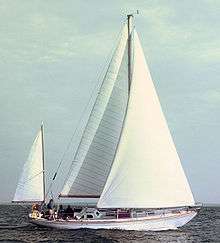Sail
A sail is a tensile structure—made from fabric or other membrane materials—that uses wind power to propel sailing craft, including sailing ships, sailboats, windsurfers, ice boats, and even sail-powered land vehicles. Sails may be made from a combination of woven materials—including canvas or polyester cloth, laminated membranes or bonded filaments—usually in a three- or four-sided shape.
A sail provides propulsive force via a combination of lift and drag, depending on its angle of attack—its angle with respect to the apparent wind. Apparent wind is the air velocity experienced on the moving craft and is the combined effect of the true wind velocity with the velocity of the sailing craft. Angle of attack is often constrained by the sailing craft's orientation to the wind or point of sail. On points of sail where it is possible to align the leading edge of the sail with the apparent wind, the sail may act as an airfoil, generating propulsive force as air passes along its surface—just as an airplane wing generates lift—which predominates over aerodynamic drag retarding forward motion. The more that the angle of attack diverges from the apparent wind as a sailing craft turns downwind, the more drag increases and lift decreases as propulsive forces, until a sail going downwind is predominated by drag forces. Sails are unable to generate propulsive force if they are aligned too closely to the wind.
Sails may be attached to a mast, boom or other spar or may be attached to a wire that is suspended by a mast. They are typically raised by a line, called a halyard, and their angle with respect to the wind is usually controlled by a line, called a sheet. In use, they may be designed to be curved in both directions along their surface, often as a result of their curved edges. Battens may be used to extend the trailing edge of a sail beyond the line of its attachment points.
Other non-rotating airfoils that power sailing craft include wingsails, which are rigid wing-like structures, and kites that power kite-rigged vessels, but do not employ a mast to support the airfoil and are beyond the scope of this article.
Rigs
Sailing craft employ two types of rig, the square rig and the fore-and-aft rig.
The square rig carries the primary driving sails are carried on horizontal spars, which are perpendicular or square, to the keel of the vessel and to the masts. These spars are called yards and their tips, beyond the last stay, are called the yardarms[1]. A ship mainly so rigged is called a square-rigger.[2] The square rig is aerodynamically most efficient when running (sailing downwind).[3]
A fore-and-aft rig consists of sails that are set along the line of the keel rather than perpendicular to it. Vessels so rigged are described as fore-and-aft rigged.[4]
History
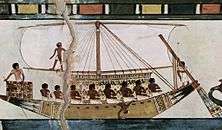
Archaeological studies of the Cucuteni-Trypillian culture ceramics show use of sailing boats from the sixth millennium BCE onwards.[5] Excavations of the Ubaid period (c. 6000–4300 BCE) in Mesopotamia provides direct evidence of sailing boats.[6]
Square rigs
Sails from ancient Egypt are depicted around 3200 BCE,[7][8] where reed boats sailed upstream against the River Nile's current. Ancient Sumerians used square rigged sailing boats at about the same time, and it is believed they established sea trading routes as far away as the Indus valley. Greeks and Phoenicians began trading by ship by around 1200 BCE.
Crab claw rigs

The first sea-going sailing ships were developed by the Austronesian peoples from what is now Southern China and Taiwan. Their invention of catamarans, outriggers, and the highly-efficient bi-sparred triangular crab claw sails enabled their ships to sail for vast distances in open ocean. It led to the Austronesian Expansion at around 3000 to 1500 BC. From Taiwan, they rapidly colonized the islands of Maritime Southeast Asia, then sailed further onwards to Micronesia, Island Melanesia, Polynesia, and Madagascar, eventually colonizing a territory spanning half the globe.[9][10][11] The proto-Austronesian words for sail, lay(r), and other rigging parts date to about 3000 BCE when this group began their Pacific expansion.[12] Austronesian rigs were distinctive in that they had spars supporting both the upper and lower edges of the sails (and sometimes in between), in contrast to western rigs which only had a spar on the upper edge.[9][10][11] The sails were also made from salt-resistant woven leaves, usually from pandan plants.[13][14]
Crab claw sails used with single-outrigger ships in Micronesia, Island Melanesia, Polynesia, and Madagascar were intrinsically unstable when tacking leeward. To deal with this, Austronesians in these regions developed the shunting technique in sailing, in conjunction with uniquely reversible single-outriggers. In the rest of Austronesia, crab claw sails were mainly for double-outrigger (trimarans) and double-hulled (catamarans) boats, which remained stable even leeward.[11][15][10][16][17]
In western Island Southeast Asia, later square sails also evolved from the crab claw sail, the tanja and the junk rig, both of which retained the Austronesian characteristic of having more than one spar supporting the sail.[18][19][20]
Junk rigs were later adopted by the Chinese Song Dynasty in the 10th century CE from contact with Srivijayan trading ships (known as "Kunlun ships" in Chinese records).[21][22]
Lateen rigs
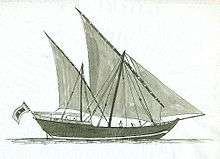
In the Mediterranean, single-yarded lateen sails emerged by around the 2nd century CE.[23][24] Though its origin remains contentious, it is believed that it developed from early contact with Southeast Asian Austronesian trading ships in the Indian Ocean with crab claw sails.[18][19][20][9]
The fore-and-aft rig began as a convention of southern Europe and the Mediterranean Sea: the generally gentle climate made its use practical, and in Italy a few centuries before the Renaissance it began to replace the square rig which had dominated all of Europe since the dawn of sea travel. Northern Europeans were resistant to adopting the fore-and-aft rig, despite having seen its use in the course of trade and during the Crusades. The Renaissance changed this: beginning in 1475, their use increased and within a hundred years the fore-and-aft rig was in common use on rivers and in estuaries in Britain, northern France, and the Low Countries, though the square rig remained standard for the harsher conditions of the open North Sea as well as for trans-Atlantic sailing. The lateen sail proved to have better upwind performance for smaller vessels.[25][26]
During the 16th-19th centuries other fore-and-aft sails were developed in Europe, such as the spritsail, gaff rig, jib, genoa, staysail, and Bermuda rig mainsail, improving the upwind sailing ability of European vessels.
Aerodynamic forces
_and_down_wind_(left).jpg)
Left-hand boat:
Down wind—predominant drag propels the boat with little heeling moment.
Right-hand boat:
Up wind (close-hauled)—predominant lift both propels the boat and contributes to heel.
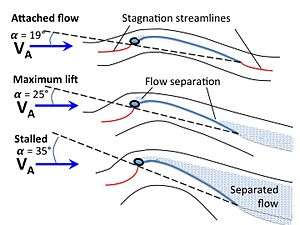
Aerodynamic forces on sails depend on wind speed and direction and the speed and direction of the craft. The direction that the craft is traveling with respect to the true wind (the wind direction and speed over the surface) is called the "point of sail". The speed of the craft at a given point of sail contributes to the apparent wind ( VA)—the wind speed and direction as measured on the moving craft. The apparent wind on the sail creates a total aerodynamic force, which may be resolved into drag—the force component in the direction of the apparent wind—and lift—the force component normal (90°) to the apparent wind. Depending on the alignment of the sail with the apparent wind, lift or drag may be the predominant propulsive component. Total aerodynamic force also resolves into a forward, propulsive, driving force—resisted by the medium through or over which the craft is passing (e.g. through water, air, or over ice, sand)—and a lateral force, resisted by the underwater foils, ice runners, or wheels of the sailing craft.[27]
For apparent wind angles aligned with the entry point of the sail, the sail acts as an airfoil and lift is the predominant component of propulsion. For apparent wind angles behind the sail, lift diminishes and drag increases as the predominant component of propulsion. For a given true wind velocity over the surface, a sail can propel a craft to a higher speed, on points of sail when the entry point of the sail is aligned with the apparent wind, than it can with the entry point not aligned, because of a combination of the diminished force from airflow around the sail and the diminished apparent wind from the velocity of the craft. Because of limitations on speed through the water, displacement sailboats generally derive power from sails generating lift on points of sail that include close-hauled through broad reach (approximately 40° to 135° off the wind).[28] Because of low friction over the surface and high speeds over the ice that create high apparent wind speeds for most points of sail, iceboats can derive power from lift further off the wind than displacement boats.[29]
- Downwind sailing with a spinnaker
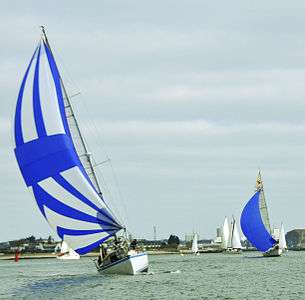 Spinnaker set for a broad reach, mobilizing both lift and drag.
Spinnaker set for a broad reach, mobilizing both lift and drag.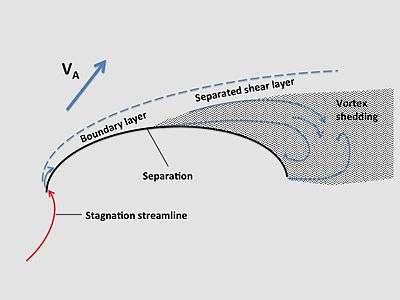 Spinnaker cross-section trimmed for a broad reach showing air flow.
Spinnaker cross-section trimmed for a broad reach showing air flow.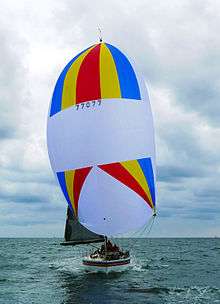 Spinnaker downwind, primarily mobilizing drag.
Spinnaker downwind, primarily mobilizing drag. Spinnaker cross-section with following apparent wind, showing air flow.
Spinnaker cross-section with following apparent wind, showing air flow.
Types

B. Square: Topsail
C. Lateen
D. Staysail
E. Gaff-rigged
G. Quadrilateral on spar
H. Loose-footed on gaff
J. Spritsail
K. Standing lug
L. Triangular
M. Dipping lug
N. Junk
Each rig is configured in a sail plan, appropriate to the size of the sailing craft. A sail plan is a set of drawings, usually prepared by a naval architect which shows the various combinations of sail proposed for a sailing ship. Sail plans may vary for different wind conditions—light to heavy. Both square-rigged and fore-and-aft rigged vessels have been built with a wide range of configurations for single and multiple masts.[31]
Types of sail that can be part of a sail plan can be broadly classed by how they are attached to the sailing craft:
- To a stay – Sails attached to stays, include jibs, which are attached to forestays and staysails, which are mounted on other stays (typically wire cable) that support other masts from the bow aft.
- To a mast – Fore-and-aft sails directly attached to the mast at the luff include gaff-rigged quadrilateral and Bermuda triangular sails.
- To a spar – Sails attached to a spar include both square sails and such fore-and-aft quadrilateral sails as lug rigs, junk and spritsails and such triangular sails as the lateen, and the crab claw.
- To a halyard – Spinnakers are the predominant sail supported solely by a halyard.
High-performance yachts, including the International C-Class Catamaran, have used or use rigid wing sails, which perform better than traditional soft sails but are more difficult to manage.[32] A rigid wing sail was used by Stars and Stripes, the defender which won the 1988 America's Cup, and by USA-17, the challenger which won the 2010 America's Cup.[33] USA 17's performance during the 2010 America's Cup races demonstrated a velocity made good upwind of over twice the wind speed and downwind of over 2.5 times the wind speed and the ability to sail as close as 20 degrees off the apparent wind.[34]
Shape
.svg.png)
The shape of a sail is defined by its edges and corners in the plane of the sail, laid out on a flat surface. The edges may be curved, either to extend the sail's shape as an airfoil or to define its shape in use. In use, the sail becomes a curved shape, adding the dimension of depth or draft.
- Edges – The top of all sails is called the head, the leading edge is called the luff on fore-and-aft sails[35] and on windward leech symmetrical sails, the trailing edge is the leech, and the bottom edge is the foot. The head is attached at the throat and peak to a gaff, yard, or sprit.[36] For a triangular sail the head refers to the topmost corner.[35]
- A fore-and-aft triangular mainsail achieves a better approximation of a wing form by extending the leech aft, beyond the line between the head and clew on an arc called the roach, rather than having a triangular shape. This added area would flutter in the wind and not contribute to the efficient airfoil shape of the sail without the presence of battens.[37] Offshore cruising mainsails sometimes have a hollow leech (the inverse of a roach) to obviate the need for battens and their ensuing likelihood of chafing the sail.[38] The roach on a square sail design is the arc of a circle above a straight line from clew to clew at the foot of a square sail, which allows the foot of the sail to clear stays coming up the mast, as the sails are rotated from side to side.[39]
- Corners – The names of corners of sails vary, depending on shape and symmetry. In a triangular sail, the corner where the luff and the leech connect is called the head.[40][35] On a square sail, the top corners are head cringles, where there are grommets, called cringles.[41] On a quadrilateral sail, the peak is the upper aft corner of the sail, at the top end of a gaff or other spar. The throat is the upper forward corner of the sail, at the bottom end of a gaff or other spar. Gaff-rigged sails, and certain similar rigs, employ two halyards to raise the sails: the throat halyard raises the forward, throat end of the gaff, while the peak halyard raises the aft, peak end.[42]
- The corner where the leech and foot connect is called the clew on a fore-and-aft sail. On a jib, the sheet is connected to the clew; on a mainsail, the sheet is connected to the boom (if present) near the clew.[35] Clews are the lower two corners of a square sail. Square sails have sheets attached to their clews like triangular sails, but the sheets are used to pull the sail down to the yard below rather than to adjust the angle it makes with the wind.[42] The corner where the leech and the foot connect is called the clew.[35] The corner on a fore-and-aft sail where the luff and foot connect is called the tack[35] and, on a mainsail, is located where the boom and mast connect.[35]
- In the case of a symmetrical spinnaker, each of the lower corners of the sail is a clew. However, under sail on a given tack, the corner to which the spinnaker sheet is attached is called the clew, and the corner attached to the spinnaker pole is referred to as the tack.[42][43] On a square sail underway, the tack is the windward clew and also the line holding down that corner.[44]
- Draft – Those triangular sails that are attached to both a mast along the luff and a boom along the foot have depth, called draft, which results from the luff and foot being curved, rather than straight as they are attached to those spars. Draft creates a more efficient airfoil shape for the sail. Draft can also be induced in triangular staysails by adjustment of the sheets and the angle from which they reach the sails.[45]
Material
Sail characteristics derive, in part, from the design, construction and the attributes of the fibers, which are woven together to make the sail cloth. There are several key factors in evaluating a fiber for suitability in weaving a sail-cloth: initial modulus, breaking strength (tenacity), creep, and flex strength. Both the initial cost and its durability of the material define its cost-effectiveness over time.[37][46]
Traditionally, sails were made from flax or cotton canvas.[46] Materials used in sails, as of the 21st century, include nylon for spinnakers—where light weight and elastic resistance to shock load are valued—and a range of fibers, used for triangular sails, that includes Dacron, aramid fibers—including Kevlar, and other liquid crystal polymer fibers—including Vectran.[46][37] Woven materials, like Dacron, may specified as either high or low tenacity, as indicated, in part by their denier count (a unit of measure for the linear mass density of fibers).[47]
Construction
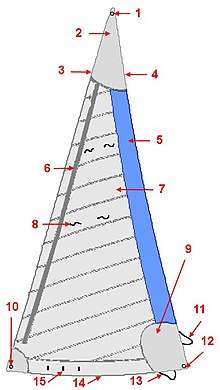
Conventional sails comprise panels, which are most often stitched together, other times adhered. There are two basic configurations, cross-cut and radial.
Cross-cut sails have the panels sewn parallel to one another, often parallel to the foot of the sail, and are the least expensive of the two sail constructions. Triangular cross-cut sail panels are designed to meet the mast and stay at an angle from either the warp or the weft (on the bias) to allow stretching along the luff, but minimize strutting on the luff and foot, where the fibers are aligned with the edges of the sail.[48]
Radial sails have panels that "radiate" from corners in order to efficiently transmit stress and are typically higher-performance than cross-cut sails. A bi-radial sail has panels radiating from two of three corners; a tri-radial sail has panels radiating from all three corners. Mainsails are more likely to be bi-radial, since there is very little stress at the tack, whereas head sails (spinnakers and jibs) are more likely to be tri-radial, because they are tensioned at their corners.[46]
Higher-performance sails may be laminated, constructed directly from multiple plies of filaments, fibers, taffetas, and films—instead of woven textiles—and adhered together. Molded sails are laminated sails formed over a curved mold and adhered together into a shape that does not lie flat.[46]
Conventional sail panels are sewn together. Sails are tensile structures, so the role of a seam is to transmit a tensile load from panel to panel. For a sewn textile sail this is done through thread and is limited by the strength of the thread and the strength of the hole in the textile through which it passes. Sail seams are often overlapped between panels and sewn with zig-zag stitches that create many connections per unit of seam length.[46][49]
Whereas textiles are typically sewn together, other sail materials may be ultrasonically welded—a technique whereby high-frequency ultrasonic acoustic vibrations are locally applied to workpieces being held together under pressure to create a solid-state weld. It is commonly used for plastics, and especially for joining dissimilar materials.[49]
Sails feature reinforcements of fabric layers where lines attach at grommets or cringles.[41] A bolt rope may be sewn onto the edges of a sail to reinforce it, or to fix the sail into a groove in the boom, in the mast, or in the luff foil of a roller-furling jib.[39] They may have stiffening features, called battens, that help shape the sail, when full length,[50] or just the roach, when present.[37] They may have a variety of means of reefing them (reducing sail area), including rows of short lines affixed to the sail to wrap up unused sail, as on square and gaff rigs,[51] or simply grommets through which a line or a hook may pass, as on Bermuda mainsails.[52] Fore-and-aft sails may have tell-tales—pieces of yarn, thread or tape that are affixed to sails—to help visualize airflow over their surfaces.[37]
Running rigging
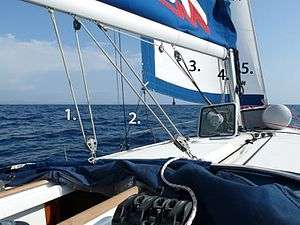
1. Main sheet
2. Jib sheet
3. Boom vang
4. Downhaul
5. Jib halyard
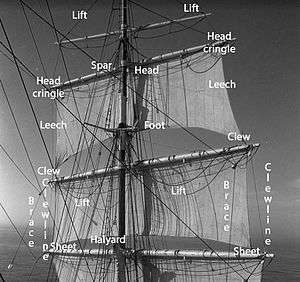
The lines that attach to and control sails are part of the running rigging and differ between square and fore-and-aft rigs. Some rigs shift from one side of the mast to the other, e.g. the dipping lug sail and the lateen. The lines can be categorized as those that support the sail, those that shape it, and those that control its angle to the wind.
Fore-and-aft rigged vessels
Fore-and-aft rigged vessels have rigging that supports, shapes, and adjusts the sails to optimize their performance in the wind, which include the following lines:
- Supporting – Halyards raise sails and control luff tension. Topping lifts hold booms and yards aloft.[53] On a gaff sail, brails run from the leech to the spar to facilitate furling.[54]
- Shaping – Barber haulers adjust a spinnaker/jib sheeting angle inboard at right angles to the sheet with a ring or clip on the sheet attached to cordage which is secured and adjusted via fairlead and cam cleat.[55] Kicking straps/boom vangs control a boom-footed sail's leech tension by exerting downward force mid-boom.[53] Cunninghams tighten the luff of a boom-footed sail by pulling downward on a cringle in the luff of a mainsail above the tack.[56] Downhauls lower a sail or a yard and can adjust the tension on the luff of a sail.[53] Outhauls control the foot tension of a boom-footed sail.[53]
- Adjusting angle to the wind – Sheets control angle of attack with respect to the apparent wind, the amount of leech "twist" near the head of the sail, and the foot tension of loose-footed sails.[53] A preventer attaches to the end of the boom from a point near the mast to prevent an accidental gybe.[53] Guys control spinnaker pole angle with respect to the apparent wind.
Square-rigged vessels
Square-rigged vessels require more controlling lines than fore-and-aft rigged ones, including the following.
- Supporting – Halyards raise and lower the yards.[53] Brails run from the leech to the spar to facilitate furling.[54] Buntlines serve to raise the foot up for shortening sail or for furling.[54] Lifts adjust the tilt of a yard, to raise or lower the ends off the horizontal.[54] Leechlines run to the leech (outer vertical edges) of a sail and serve to pull the leech both in and up when furling.[54]
- Shaping – Bowlines run from the leech forward towards the bow to control the weather leech, keeping it taut and thus preventing it from curling back on itself.[54] Clewlines raise the clews to the yard above.[54]
- Adjusting angle to the wind – Braces adjust the fore and aft angle of a yard (i.e. to rotate the yard laterally, fore and aft, around the mast).[54] Sheets attach to the clew to control the sail's angle to the wind.[54] Tacks haul the clew of a square sail forward.[54]
Gallery
Sails on high-performance sailing craft.

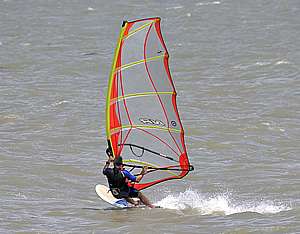
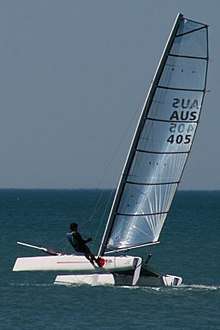
 DN class ice boat.
DN class ice boat.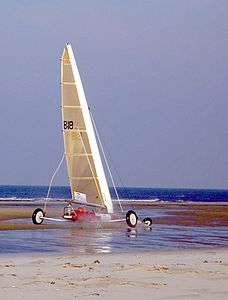 Land sailing craft.
Land sailing craft.
Sails on craft subject to low forward resistance and high lateral resistance typically have full-length battens.[50]
See also
|
|
|
|
Legend
- Genoa jib
- Head
- Reinforcement
- Luff
- Leech
- Anti-UV covering
- Head foil attachment
- Panel(s)
- Telltales
- Reinforcement
- Tack
- Leech control
- Clew
- Foot control
- Foot
- Furling marks
References
- Oxford English Dictionary
- Keegan, John (1989). The Price of Admiralty. New York: Viking. p. 280. ISBN 0-670-81416-4.
- Mclaughlan, Ian (2014). The Sloop of War: 1650-1763. Seaforth Publishing. p. 288. ISBN 9781848321878. Archived from the original on 2017-11-11.
- Knight, Austin Melvin (1910). Modern seamanship. New York: D. Van Nostrand. pp. 507–532.
- Gimbutas, Marija (2007). "1". The goddesses and gods of Old Europe, 6500–3500 BCE: myths and cult images (New and updated ed.). Berkeley: University of California Press. p. 18. ISBN 9780520253988.
The use of sailing-boats is attested from the sixth millenium onwards by their incised depiction on ceramics.
- Carter, Robert (2012). "19". In Potts, D.T. (ed.). A companion to the archaeology of the ancient Near East. Ch 19 Watercraft. Chichester, West Sussex: Wiley-Blackwell. pp. 347–354. ISBN 978-1-4051-8988-0. Archived from the original on 28 April 2015. Retrieved 8 February 2014.
- John Coleman Darnell (2006). "The Wadi of the Horus Qa-a: A Tableau of Royal Ritual Power in the Theban Western Desert". Yale. Archived from the original on 2011-02-01. Retrieved 2010-08-24.
- The sea-craft of prehistory, p76, by Paul Johnstone, Routledge, 1980
- Meacham, Steve (11 December 2008). "Austronesians were first to sail the seas". The Sydney Morning Herald. Retrieved 28 April 2019.
- Doran, Edwin, Jr. (1974). "Outrigger Ages". The Journal of the Polynesian Society. 83 (2): 130–140.
- Mahdi, Waruno (1999). "The Dispersal of Austronesian boat forms in the Indian Ocean". In Blench, Roger; Spriggs, Matthew (eds.). Archaeology and Language III: Artefacts languages, and texts. One World Archaeology. 34. Routledge. pp. 144–179. ISBN 978-0415100540.
- Lewis, David (1994). We, the Navigators : the ancient art of landfinding in the Pacific (2nd ed.). Honolulu: University of Hawaii Press. p. 7. ISBN 0-8248-1582-3.
- Kirch, Patrick Vinton (2012). A Shark Going Inland Is My Chief: The Island Civilization of Ancient Hawai'i. University of California Press. pp. 25–26. ISBN 9780520953833.
- Gallaher, Timothy (2014). "The Past and Future of Hala (Pandanus tectorius) in Hawaii". In Keawe, Lia O'Neill M.A.; MacDowell, Marsha; Dewhurst, C. Kurt (eds.). ʻIke Ulana Lau Hala: The Vitality and Vibrancy of Lau Hala Weaving Traditions in Hawaiʻi. Hawai'inuiakea School of Hawaiian Knowledge ; University of Hawai'i Press. doi:10.13140/RG.2.1.2571.4648. ISBN 9780824840938.
- Doran, Edwin B. (1981). Wangka: Austronesian Canoe Origins. Texas A&M University Press. ISBN 9780890961070.
- Beheim, B. A.; Bell, A. V. (23 February 2011). "Inheritance, ecology and the evolution of the canoes of east Oceania". Proceedings of the Royal Society B: Biological Sciences. 278 (1721): 3089–3095. doi:10.1098/rspb.2011.0060. PMC 3158936. PMID 21345865.
- Hornell, James (1932). "Was the Double-Outrigger Known in Polynesia and Micronesia? A Critical Study". The Journal of the Polynesian Society. 41 (2 (162)): 131–143.
- Shaffer, Lynda Norene (1996). Maritime Southeast Asia to 1500. M.E. Sharpe.
- Hourani, George Fadlo (1951). Arab Seafaring in the Indian Ocean in Ancient and Early Medieval Times. New Jersey: Princeton University Press.
- Johnstone, Paul (1980). The Seacraft of Prehistory. Cambridge: Harvard University Press. ISBN 978-0674795952.
- L. Pham, Charlotte Minh-Hà (2012). Asian Shipbuilding Technology. Bangkok: UNESCO Bangkok Asia and Pacific Regional Bureau for Education. p. 20. ISBN 978-92-9223-413-3.
- Maguin, Pierre-Yves (September 1980). "The Southeast Asian Ship: An Historical Approach". Journal of Southeast Asian Studies. 11 (2): 266–276. doi:10.1017/S002246340000446X. JSTOR 20070359.
- I. C. Campbell, "The Lateen Sail in World History" Archived 2016-08-04 at the Wayback Machine, Journal of World History (University of Hawaii), 6.1 (Spring 1995), p. 1–23
- Marchaj, Czeslaw A. Sail Performance, Techniques to Maximize Sail Power, Revised Edition. London: Adlard Coles Nautical, 2003. Part 2 Aerodynamics of sails, Chapter 11 "The Sail Power of Various Rigs"
- Chatterton, Edward Keble (1912). Fore and aft. London: J. B. Lippincott. p. 203. OCLC 651733391.
fore and aft rig schooner.
- Castro, F.; Fonseca, N.; Vacas, T.; Ciciliot, F. (2008), "A Quantitative Look at Mediterranean Lateen- and Square-Rigged Ships (Part 1)", The International Journal of Nautical Archaeology, 37 (2), pp. 347–359, doi:10.1111/j.1095-9270.2008.00183.x
- Clancy, L.J. (1975), Aerodynamics, London: Pitman Publishing Limited, p. 638, ISBN 0-273-01120-0
- Jobson, Gary (1990). Championship Tactics: How Anyone Can Sail Faster, Smarter, and Win Races. New York: St. Martin's Press. pp. 323. ISBN 0-312-04278-7.
- Bethwaite, Frank (2007). High Performance Sailing. Adlard Coles Nautical. ISBN 978-0-7136-6704-2.
- Clerc-Rampal, G. (1913) Mer : la Mer Dans la Nature, la Mer et l'Homme, Paris: Librairie Larousse, p. 213
- Folkard, Henry Coleman (2012). Sailing Boats from Around the World: The Classic 1906 Treatise. Dover Maritime. Courier Corporation. p. 576. ISBN 9780486311340. Archived from the original on 2017-11-11.
- Nielsen, Peter (May 14, 2014). "Have Wingsails Gone Mainstream?". Sail. Archived from the original on April 12, 2015. Retrieved 2015-01-24.
- "America's cup: BMW Oracle Racing pushes edge in 90-foot trimaran". International Herald Tribune. 2008-11-08. Archived from the original on 2008-12-11. Retrieved 2009-03-07.
- Swintal, Diane (13 August 2009). "Russell Coutts Talks About BMW Oracle's Giant Multi-hull". cupinfo.com. Archived from the original on 17 February 2012. Retrieved 2012-04-25.
- SAIL Editors. "Know How: Sailing 101". Sail Magazine. Archived from the original on 5 October 2016. Retrieved 4 October 2016.
- King, Hattendorf & Estes 2000, p. 283.
- Textor, Ken (1995). The New Book of Sail Trim. Sheridan House, Inc. p. 228. ISBN 0924486813. Archived from the original on 2016-05-17.
- Nicolson, Ian (1998). A Sail for All Seasons: Cruising and Racing Sail Tips. Sheridan House, Inc. p. 124. ISBN 9781574090475. Archived from the original on 2017-11-11.
- Kipping, Robert (1847). The Elements of Sailmaking: Being a Complete Treatise on Cutting-out Sails, According to the Most Approved Methods in the Merchant Service... F.W. Norie & Wilson. pp. 58–72.
- Jobson, Gary (2008). Sailing Fundamentals (Revised ed.). New York: Simon and Schuster. p. 224. ISBN 978-1439136782. Archived from the original on 2017-11-11.CS1 maint: ref=harv (link)
-
Knight, Austin N. (1921). Modern Seamanship (8 ed.). New York: D. van Nostrand Company. pp. 831.
head cringle.
- King, Dean; Hattendorf, John B.; Estes, J W. (2000). A sea of words: a lexicon and companion for Patrick O'Brian's seafaring tales (3 ed.). New York: Henry Holt. p. 518. ISBN 978-0-8050-6615-9. Archived from the original on 2017-11-11.
- "Sailing Quick Reference Guide" (PDF). Wayzata Yacht Club. Wayzata Yacht Club. Archived (PDF) from the original on 5 January 2017. Retrieved 4 October 2016.
- King, Hattendorf & Estes 2000, p. 416.
- Jinks, Simon. "Adjusting Sail Draft". Royal Yachting Association. Royal Yachting Association. Archived from the original on 5 October 2016. Retrieved 4 October 2016.
-
Hancock, Brian; Knox-Johnson, Robin (2003). Maximum Sail Power: The Complete Guide to Sails, Sail Technology, and Performance. Nomad Press. pp. 288. ISBN 9781619304277.
sail panel cut.
- Rice, Carol (January 1995), "A first-time buyers checklist", Cruising World, 21, pp. 34–35, ISSN 0098-3519, archived from the original on 2017-11-11, retrieved 2017-01-13
- Colgate, Stephen (1996). Fundamentals of Sailing, Cruising, and Racing. W. W. Norton & Company. p. 384. ISBN 9780393038118. Archived from the original on 2017-11-11.
- Jones, I.; Stylios, G.K. (2013), Joining Textiles: Principles and Applications, Woodhead Publishing Series in Textiles, Elsevier, p. 624, ISBN 9780857093967, retrieved 2017-01-12
-
Berman, Phil (1999). Catamaran Sailing: From Start to Finish. W. W. Norton & Company. pp. 219. ISBN 9780393318807.
Catamaran batten.
- Cunliffe, Tom (2004). Hand, Reef and Steer. Sheridan House, Inc. p. 178. ISBN 9781574092035. Archived from the original on 2017-11-11.
- Hahne, Peter (2005). Sail Trim: Theory and Practice. Sheridan House, Inc. p. 120. ISBN 9781574091984.
- Howard, Jim; Doane, Charles J. (2000). Handbook of Offshore Cruising: The Dream and Reality of Modern Ocean Cruising. Sheridan House, Inc. p. 468. ISBN 9781574090932.
-
Biddlecombe, George (1990). The Art of Rigging: Containing an Explanation of Terms and Phrases and the Progressive Method of Rigging Expressly Adapted for Sailing Ships. Dover Maritime Series. Courier Corporation. pp. 155. ISBN 9780486263434.
The Art of Rigging: Containing an Explanation of Terms and Phrases and the ... By George Biddlecombe.
- Schweer, Peter (2006). How to Trim Sails. Sailmate. Sheridan House, Inc. p. 105. ISBN 9781574092202.
- Holmes, Rupert; Evans, Jeremy (2014). The Dinghy Bible: The Complete Guide for Novices and Experts. A&C Black. p. 192. ISBN 9781408188002.
Further reading
- Chapman Piloting & Seamanship. Maloney, Elbert S., Chapman, Charles F. (Charles Frederic), 1881-1976. (65th ed.). New York: Hearst Books. 2006. ISBN 1-58816-232-X. OCLC 71291743.CS1 maint: others (link)
- Crothers, William L. (2014). The Masting of American Merchant Sail in the 1850s An Illustrated Study. Jefferson, North Carolina: McFarland Publishing. ISBN 9780786493999.
- Hancock, Brian. (2003). Maximum Sail Power : the Complete Guide to Sails, Sail Technology, and Performance (PDF). New York: Nomad Press. ISBN 978-1-61930-427-7. OCLC 913696173.
- The Sailor's Handbook : The Essential Sailing Manual. Herreshoff, Halsey C. [Place of publication not identified]: International Marine. 2006. ISBN 978-0-07-148092-5. OCLC 76941837.CS1 maint: others (link)
- Jobson, Gary. (8 September 2008). Sailing Fundamentals : The Official Learn-to-Sail Manual of the American Sailing Association and the United States Coast Guard Auxiliary. Betz, Marti., American Sailing Association., United States. Coast Guard Auxiliary. (Revised and updatedition ed.). New York. ISBN 978-1-4391-3678-2. OCLC 892057802.
- Marchaj, C. A. (Czesaw Antony), 1918- (2003). Sail Performance: Techniques to Maximise Sail Power (Rev. ed.). London: Adlard Coles Nautical. ISBN 0-7136-6407-X. OCLC 50841634.CS1 maint: multiple names: authors list (link)
- Marino, Emiliano. (2001). The Sailmaker's Apprentice : A Guide for the Self-Reliant Sailor. Camden, Me.: International Marine. ISBN 0-07-137642-9. OCLC 48258636.
- Rousmaniere, John (7 January 2014). The Annapolis Book of Seamanship. Smith, Mark (Mark E.) (Fourth ed.). New York. ISBN 978-1-4516-5019-8. OCLC 862092350.
- Seidman, David. (2011). The Complete Sailor : Learning the Art of Sailing (2nd ed.). Camden, Me.: International Marine/McGraw-Hill. ISBN 978-0-07-174957-2. OCLC 704984188.
External links
| Wikimedia Commons has media related to sails. |
| Look up sail in Wiktionary, the free dictionary. |

